+ Open data
Open data
- Basic information
Basic information
| Entry | Database: PDB / ID: 7p02 | |||||||||
|---|---|---|---|---|---|---|---|---|---|---|
| Title | Human Neurokinin 1 receptor (NK1R) substance P Gs complex | |||||||||
 Components Components |
| |||||||||
 Keywords Keywords |  MEMBRANE PROTEIN / Receptor / MEMBRANE PROTEIN / Receptor /  Complex / Complex /  Eukaryotic protein Eukaryotic protein | |||||||||
| Function / homology |  Function and homology information Function and homology informationsubstance P receptor binding / substance P receptor activity /  insemination / insemination /  tachykinin receptor activity / positive regulation of flagellated sperm motility / tachykinin receptor activity / positive regulation of flagellated sperm motility /  aggressive behavior / Tachykinin receptors bind tachykinins / positive regulation of uterine smooth muscle contraction / detection of abiotic stimulus / positive regulation of synaptic transmission, cholinergic ...substance P receptor binding / substance P receptor activity / aggressive behavior / Tachykinin receptors bind tachykinins / positive regulation of uterine smooth muscle contraction / detection of abiotic stimulus / positive regulation of synaptic transmission, cholinergic ...substance P receptor binding / substance P receptor activity /  insemination / insemination /  tachykinin receptor activity / positive regulation of flagellated sperm motility / tachykinin receptor activity / positive regulation of flagellated sperm motility /  aggressive behavior / Tachykinin receptors bind tachykinins / positive regulation of uterine smooth muscle contraction / detection of abiotic stimulus / positive regulation of synaptic transmission, cholinergic / aggressive behavior / Tachykinin receptors bind tachykinins / positive regulation of uterine smooth muscle contraction / detection of abiotic stimulus / positive regulation of synaptic transmission, cholinergic /  operant conditioning / operant conditioning /  sperm head / sperm ejaculation / positive regulation of lymphocyte proliferation / tachykinin receptor signaling pathway / response to ozone / response to auditory stimulus / positive regulation of action potential / smooth muscle contraction involved in micturition / positive regulation of blood pressure / regulation of smooth muscle cell proliferation / positive regulation of hormone secretion / positive regulation of vascular permeability / positive regulation of ossification / regulation of smooth muscle cell migration / positive regulation of leukocyte migration / response to pain / sperm head / sperm ejaculation / positive regulation of lymphocyte proliferation / tachykinin receptor signaling pathway / response to ozone / response to auditory stimulus / positive regulation of action potential / smooth muscle contraction involved in micturition / positive regulation of blood pressure / regulation of smooth muscle cell proliferation / positive regulation of hormone secretion / positive regulation of vascular permeability / positive regulation of ossification / regulation of smooth muscle cell migration / positive regulation of leukocyte migration / response to pain /  eating behavior / positive regulation of epithelial cell migration / behavioral response to pain / angiotensin-mediated drinking behavior / PKA activation in glucagon signalling / eating behavior / positive regulation of epithelial cell migration / behavioral response to pain / angiotensin-mediated drinking behavior / PKA activation in glucagon signalling /  associative learning / hair follicle placode formation / associative learning / hair follicle placode formation /  intracellular transport / Adenylate cyclase inhibitory pathway / intracellular transport / Adenylate cyclase inhibitory pathway /  D1 dopamine receptor binding / developmental growth / positive regulation of protein localization to cell cortex / neuropeptide signaling pathway / D1 dopamine receptor binding / developmental growth / positive regulation of protein localization to cell cortex / neuropeptide signaling pathway /  long-term memory / regulation of cAMP-mediated signaling / sperm flagellum / D2 dopamine receptor binding / G protein-coupled serotonin receptor binding / Hedgehog 'off' state / positive regulation of cAMP-mediated signaling / adenylate cyclase-activating adrenergic receptor signaling pathway / response to electrical stimulus / regulation of mitotic spindle organization / cellular response to forskolin / positive regulation of vasoconstriction / sensory perception of pain / positive regulation of stress fiber assembly / sperm midpiece / adenylate cyclase-inhibiting G protein-coupled receptor signaling pathway / activation of adenylate cyclase activity / adenylate cyclase activator activity / cellular response to nerve growth factor stimulus / trans-Golgi network membrane / response to progesterone / response to nicotine / Regulation of insulin secretion / G protein-coupled receptor binding / positive regulation of epithelial cell proliferation / positive regulation of synaptic transmission, GABAergic / G-protein beta/gamma-subunit complex binding / Olfactory Signaling Pathway / Activation of the phototransduction cascade / G beta:gamma signalling through PLC beta / Presynaptic function of Kainate receptors / Thromboxane signalling through TP receptor / adenylate cyclase-modulating G protein-coupled receptor signaling pathway / long-term memory / regulation of cAMP-mediated signaling / sperm flagellum / D2 dopamine receptor binding / G protein-coupled serotonin receptor binding / Hedgehog 'off' state / positive regulation of cAMP-mediated signaling / adenylate cyclase-activating adrenergic receptor signaling pathway / response to electrical stimulus / regulation of mitotic spindle organization / cellular response to forskolin / positive regulation of vasoconstriction / sensory perception of pain / positive regulation of stress fiber assembly / sperm midpiece / adenylate cyclase-inhibiting G protein-coupled receptor signaling pathway / activation of adenylate cyclase activity / adenylate cyclase activator activity / cellular response to nerve growth factor stimulus / trans-Golgi network membrane / response to progesterone / response to nicotine / Regulation of insulin secretion / G protein-coupled receptor binding / positive regulation of epithelial cell proliferation / positive regulation of synaptic transmission, GABAergic / G-protein beta/gamma-subunit complex binding / Olfactory Signaling Pathway / Activation of the phototransduction cascade / G beta:gamma signalling through PLC beta / Presynaptic function of Kainate receptors / Thromboxane signalling through TP receptor / adenylate cyclase-modulating G protein-coupled receptor signaling pathway /  bone development / G-protein activation / G protein-coupled acetylcholine receptor signaling pathway / Activation of G protein gated Potassium channels / Inhibition of voltage gated Ca2+ channels via Gbeta/gamma subunits / Prostacyclin signalling through prostacyclin receptor / Glucagon signaling in metabolic regulation / G beta:gamma signalling through CDC42 / adenylate cyclase-activating G protein-coupled receptor signaling pathway / ADP signalling through P2Y purinoceptor 12 / G beta:gamma signalling through BTK / Sensory perception of sweet, bitter, and umami (glutamate) taste / response to peptide hormone / Synthesis, secretion, and inactivation of Glucagon-like Peptide-1 (GLP-1) / photoreceptor disc membrane / Adrenaline,noradrenaline inhibits insulin secretion / bone development / G-protein activation / G protein-coupled acetylcholine receptor signaling pathway / Activation of G protein gated Potassium channels / Inhibition of voltage gated Ca2+ channels via Gbeta/gamma subunits / Prostacyclin signalling through prostacyclin receptor / Glucagon signaling in metabolic regulation / G beta:gamma signalling through CDC42 / adenylate cyclase-activating G protein-coupled receptor signaling pathway / ADP signalling through P2Y purinoceptor 12 / G beta:gamma signalling through BTK / Sensory perception of sweet, bitter, and umami (glutamate) taste / response to peptide hormone / Synthesis, secretion, and inactivation of Glucagon-like Peptide-1 (GLP-1) / photoreceptor disc membrane / Adrenaline,noradrenaline inhibits insulin secretion /  platelet aggregation / Glucagon-type ligand receptors / platelet aggregation / Glucagon-type ligand receptors /  cognition / Vasopressin regulates renal water homeostasis via Aquaporins / positive regulation of GTPase activity / G alpha (z) signalling events / cellular response to catecholamine stimulus / Glucagon-like Peptide-1 (GLP1) regulates insulin secretion / ADORA2B mediated anti-inflammatory cytokines production / adenylate cyclase-activating dopamine receptor signaling pathway / ADP signalling through P2Y purinoceptor 1 cognition / Vasopressin regulates renal water homeostasis via Aquaporins / positive regulation of GTPase activity / G alpha (z) signalling events / cellular response to catecholamine stimulus / Glucagon-like Peptide-1 (GLP1) regulates insulin secretion / ADORA2B mediated anti-inflammatory cytokines production / adenylate cyclase-activating dopamine receptor signaling pathway / ADP signalling through P2Y purinoceptor 1Similarity search - Function | |||||||||
| Biological species |   Mus musculus (house mouse) Mus musculus (house mouse)  Homo sapiens (human) Homo sapiens (human) | |||||||||
| Method |  ELECTRON MICROSCOPY / ELECTRON MICROSCOPY /  single particle reconstruction / single particle reconstruction /  cryo EM / Resolution: 2.87 Å cryo EM / Resolution: 2.87 Å | |||||||||
 Authors Authors | Thom, C. / Ehrenmann, J. / Vacca, S. / Waltenspuhl, Y. / Schoppe, J. / Medalia, O. / Pluckthun, A. | |||||||||
| Funding support |  Switzerland, 2items Switzerland, 2items
| |||||||||
 Citation Citation |  Journal: Sci Adv / Year: 2021 Journal: Sci Adv / Year: 2021Title: Structures of neurokinin 1 receptor in complex with G and G proteins reveal substance P binding mode and unique activation features. Authors: Cristian Thom / Janosch Ehrenmann / Santiago Vacca / Yann Waltenspühl / Jendrik Schöppe / Ohad Medalia / Andreas Plückthun /  Abstract: The neurokinin 1 receptor (NKR) is involved in inflammation and pain transmission. This pathophysiologically important G protein–coupled receptor is predominantly activated by its cognate agonist ...The neurokinin 1 receptor (NKR) is involved in inflammation and pain transmission. This pathophysiologically important G protein–coupled receptor is predominantly activated by its cognate agonist substance P (SP) but also by the closely related neurokinins A and B. Here, we report cryo–electron microscopy structures of SP-bound NKR in complex with its primary downstream signal mediators, G and G. Our structures reveal how a polar network at the extracellular, solvent-exposed receptor surface shapes the orthosteric pocket and that NKR adopts a noncanonical active-state conformation with an interface for G protein binding, which is distinct from previously reported structures. Detailed comparisons with antagonist-bound NKR crystal structures reveal that insurmountable antagonists induce a distinct and long-lasting receptor conformation that sterically blocks SP binding. Together, our structures provide important structural insights into ligand and G protein promiscuity, the lack of basal signaling, and agonist- and antagonist-induced conformations in the neurokinin receptor family. | |||||||||
| History |
|
- Structure visualization
Structure visualization
| Movie |
 Movie viewer Movie viewer |
|---|---|
| Structure viewer | Molecule:  Molmil Molmil Jmol/JSmol Jmol/JSmol |
- Downloads & links
Downloads & links
- Download
Download
| PDBx/mmCIF format |  7p02.cif.gz 7p02.cif.gz | 214.1 KB | Display |  PDBx/mmCIF format PDBx/mmCIF format |
|---|---|---|---|---|
| PDB format |  pdb7p02.ent.gz pdb7p02.ent.gz | 171.7 KB | Display |  PDB format PDB format |
| PDBx/mmJSON format |  7p02.json.gz 7p02.json.gz | Tree view |  PDBx/mmJSON format PDBx/mmJSON format | |
| Others |  Other downloads Other downloads |
-Validation report
| Arichive directory |  https://data.pdbj.org/pub/pdb/validation_reports/p0/7p02 https://data.pdbj.org/pub/pdb/validation_reports/p0/7p02 ftp://data.pdbj.org/pub/pdb/validation_reports/p0/7p02 ftp://data.pdbj.org/pub/pdb/validation_reports/p0/7p02 | HTTPS FTP |
|---|
-Related structure data
| Related structure data |  13141MC  7p00C M: map data used to model this data C: citing same article ( |
|---|---|
| Similar structure data |
- Links
Links
- Assembly
Assembly
| Deposited unit | 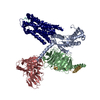
|
|---|---|
| 1 |
|
- Components
Components
-Guanine nucleotide-binding protein ... , 3 types, 3 molecules BGA
| #2: Protein | Mass: 39086.641 Da / Num. of mol.: 1 Source method: isolated from a genetically manipulated source Source: (gene. exp.)   Homo sapiens (human) / Gene: GNB1 / Production host: Homo sapiens (human) / Gene: GNB1 / Production host:   Spodoptera frugiperda (fall armyworm) / References: UniProt: P62873 Spodoptera frugiperda (fall armyworm) / References: UniProt: P62873 |
|---|---|
| #3: Protein | Mass: 7861.143 Da / Num. of mol.: 1 Source method: isolated from a genetically manipulated source Source: (gene. exp.)   Homo sapiens (human) / Gene: GNG2 / Production host: Homo sapiens (human) / Gene: GNG2 / Production host:   Spodoptera frugiperda (fall armyworm) / References: UniProt: P59768 Spodoptera frugiperda (fall armyworm) / References: UniProt: P59768 |
| #4: Protein | Mass: 28428.365 Da / Num. of mol.: 1 Source method: isolated from a genetically manipulated source Source: (gene. exp.)   Homo sapiens (human) / Gene: GNAI1, GNAS, GNAS1, GSP / Production host: Homo sapiens (human) / Gene: GNAI1, GNAS, GNAS1, GSP / Production host:   Spodoptera frugiperda (fall armyworm) / References: UniProt: P63096, UniProt: P63092 Spodoptera frugiperda (fall armyworm) / References: UniProt: P63096, UniProt: P63092 |
-Antibody / Protein / Protein/peptide / Non-polymers , 4 types, 4 molecules HRP

| #1: Antibody | Mass: 32409.229 Da / Num. of mol.: 1 Source method: isolated from a genetically manipulated source Source: (gene. exp.)   Mus musculus (house mouse) / Production host: Mus musculus (house mouse) / Production host:   Spodoptera frugiperda (fall armyworm) Spodoptera frugiperda (fall armyworm) |
|---|---|
| #5: Protein | Mass: 44218.668 Da / Num. of mol.: 1 Source method: isolated from a genetically manipulated source Source: (gene. exp.)   Homo sapiens (human) / Gene: TACR1, NK1R, TAC1R / Production host: Homo sapiens (human) / Gene: TACR1, NK1R, TAC1R / Production host:   Spodoptera frugiperda (fall armyworm) / References: UniProt: P25103 Spodoptera frugiperda (fall armyworm) / References: UniProt: P25103 |
| #6: Protein/peptide | Mass: 1348.637 Da / Num. of mol.: 1 Source method: isolated from a genetically manipulated source Source: (gene. exp.)   Homo sapiens (human) / Gene: TAC1, NKA, NKNA, TAC2 / Production host: Homo sapiens (human) / Gene: TAC1, NKA, NKNA, TAC2 / Production host:   Spodoptera frugiperda (fall armyworm) / References: UniProt: P20366 Spodoptera frugiperda (fall armyworm) / References: UniProt: P20366 |
| #7: Chemical | ChemComp-CLR /  Cholesterol Cholesterol |
-Details
| Has ligand of interest | N |
|---|
-Experimental details
-Experiment
| Experiment | Method:  ELECTRON MICROSCOPY ELECTRON MICROSCOPY |
|---|---|
| EM experiment | Aggregation state: PARTICLE / 3D reconstruction method:  single particle reconstruction single particle reconstruction |
- Sample preparation
Sample preparation
| Component | Name: NK1R in complex with Substance P, heterotrimeric mini-Gs chimera (Gsi) and scFv16 Type: COMPLEX / Entity ID: #1-#6 / Source: RECOMBINANT |
|---|---|
| Source (natural) | Organism:   Homo sapiens (human) Homo sapiens (human) |
| Source (recombinant) | Organism:   Spodoptera frugiperda (fall armyworm) Spodoptera frugiperda (fall armyworm) |
| Buffer solution | pH: 7.5 |
| Specimen | Conc.: 1 mg/ml / Embedding applied: NO / Shadowing applied: NO / Staining applied : NO / Vitrification applied : NO / Vitrification applied : YES : YES |
| Specimen support | Grid material: GOLD / Grid type: Quantifoil R1.2/1.3 |
Vitrification | Instrument: FEI VITROBOT MARK IV / Cryogen name: ETHANE / Humidity: 100 % / Chamber temperature: 277 K |
- Electron microscopy imaging
Electron microscopy imaging
| Experimental equipment |  Model: Titan Krios / Image courtesy: FEI Company |
|---|---|
| Microscopy | Model: FEI TITAN KRIOS |
| Electron gun | Electron source : :  FIELD EMISSION GUN / Accelerating voltage: 300 kV / Illumination mode: FLOOD BEAM FIELD EMISSION GUN / Accelerating voltage: 300 kV / Illumination mode: FLOOD BEAM |
| Electron lens | Mode: BRIGHT FIELD Bright-field microscopy / Nominal magnification: 130000 X / Nominal defocus max: 2400 nm / Calibrated defocus min: 800 nm / Cs Bright-field microscopy / Nominal magnification: 130000 X / Nominal defocus max: 2400 nm / Calibrated defocus min: 800 nm / Cs : 2.7 mm : 2.7 mm |
| Specimen holder | Cryogen: NITROGEN |
| Image recording | Electron dose: 63.51 e/Å2 / Film or detector model: GATAN K3 BIOQUANTUM (6k x 4k) |
- Processing
Processing
| Software | Name: PHENIX / Version: 1.19.1_4122: / Classification: refinement | ||||||||||||||||||||||||
|---|---|---|---|---|---|---|---|---|---|---|---|---|---|---|---|---|---|---|---|---|---|---|---|---|---|
| EM software |
| ||||||||||||||||||||||||
CTF correction | Type: PHASE FLIPPING AND AMPLITUDE CORRECTION | ||||||||||||||||||||||||
| Particle selection | Num. of particles selected: 4227825 | ||||||||||||||||||||||||
3D reconstruction | Resolution: 2.87 Å / Resolution method: FSC 0.143 CUT-OFF / Num. of particles: 395052 / Symmetry type: POINT | ||||||||||||||||||||||||
| Refine LS restraints |
|
 Movie
Movie Controller
Controller




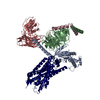


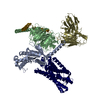
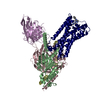
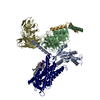

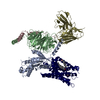
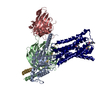
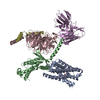
 PDBj
PDBj

































